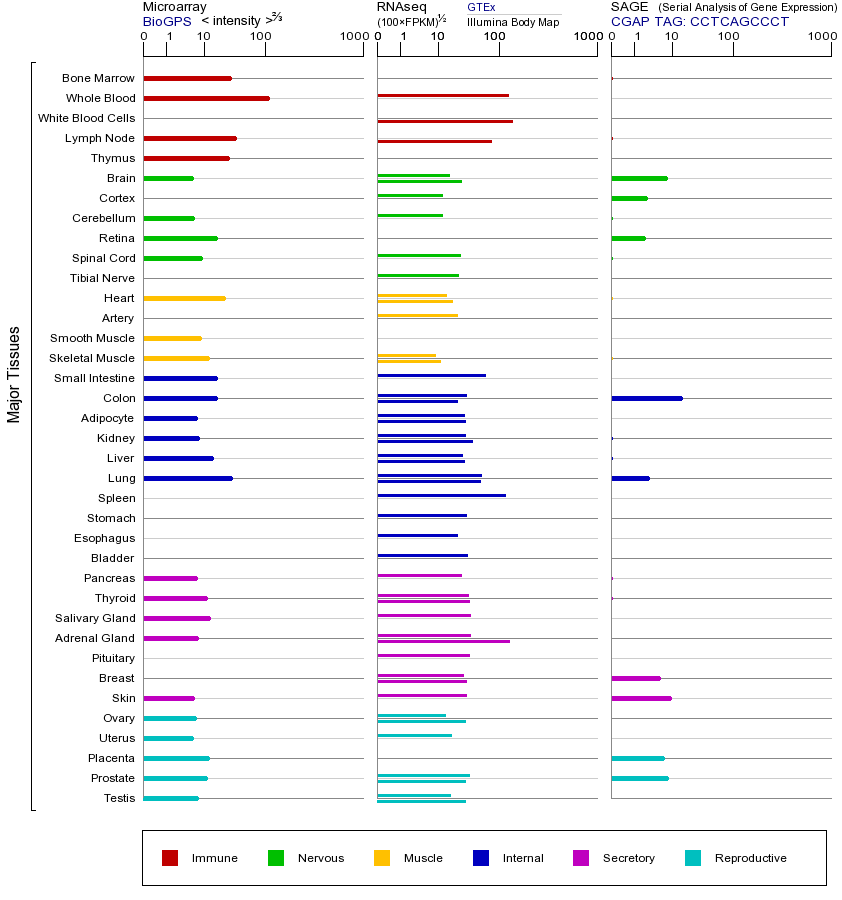PTPN6 (protein tyrosine phosphatase non-receptor type 6)
- symbol:
- PTPN6
- locus group:
- protein-coding gene
- location:
- 12p13.31
- gene_family:
- SH2 domain containing|Protein tyrosine phosphatases, non-receptor type
- alias symbol:
- HCP|HCPH|PTP-1C|SHP-1|SHP1
- alias name:
- None
- entrez id:
- 5777
- ensembl gene id:
- ENSG00000111679
- ucsc gene id:
- uc001qsa.1
- refseq accession:
- NM_002831
- hgnc_id:
- HGNC:9658
- approved reserved:
- 1992-02-12
PTPN6(Protein Tyrosine Phosphatase Non-Receptor Type 6),也称为SHP-1(Src Homology 2 domain-containing Phosphatase-1),是一种非受体型蛋白酪氨酸磷酸酶,属于PTP(Protein Tyrosine Phosphatase)基因家族。PTP家族的主要功能是通过去磷酸化调控信号转导通路,影响细胞增殖、分化、凋亡和免疫反应等过程。PTPN6主要在造血细胞中表达,其结构包含两个SH2结构域和一个催化结构域,通过SH2结构域与磷酸化的酪氨酸残基结合,从而负调控多种信号通路,如JAK/STAT、MAPK和PI3K/AKT等。PTPN6通过去磷酸化作用抑制过度激活的免疫反应,维持免疫稳态。PTPN6的功能异常与多种疾病相关,其突变或表达异常可导致自身免疫性疾病、炎症性疾病和癌症。例如,PTPN6功能丧失性突变与小鼠的“motheaten”表型相关,表现为严重的自身免疫和炎症反应。在人类中,PTPN6的表达降低或功能缺失与系统性红斑狼疮(SLE)、类风湿性关节炎(RA)等自身免疫性疾病的发生有关。此外,PTPN6在某些癌症中表达异常,如在白血病和淋巴瘤中可能作为抑癌基因发挥作用,其表达降低可能导致细胞增殖失控。PTPN6的过表达可能抑制免疫细胞的活化,导致免疫抑制或感染易感性增加;而表达降低则可能引发过度免疫反应或自身免疫疾病。PTPN6与PTPN11(SHP-2)同属SHP亚家族,两者结构相似但功能不同,PTPN11通常促进信号传导,而PTPN6主要起抑制作用。PTPN6的调控异常还可能影响其他基因的表达或功能,如STAT蛋白的磷酸化状态,从而改变下游基因的转录活性。总之,PTPN6在免疫调节和细胞信号转导中发挥关键作用,其表达或功能异常与多种疾病密切相关。
The protein encoded by this gene is a member of the protein tyrosine phosphatase (PTP) family. PTPs are known to be signaling molecules that regulate a variety of cellular processes including cell growth, differentiation, mitotic cycle, and oncogenic transformation. N-terminal part of this PTP contains two tandem Src homolog (SH2) domains, which act as protein phospho-tyrosine binding domains, and mediate the interaction of this PTP with its substrates. This PTP is expressed primarily in hematopoietic cells, and functions as an important regulator of multiple signaling pathways in hematopoietic cells. This PTP has been shown to interact with, and dephosphorylate a wide spectrum of phospho-proteins involved in hematopoietic cell signaling. Multiple alternatively spliced variants of this gene, which encode distinct isoforms, have been reported. [provided by RefSeq, Jul 2008]
由该基因编码的蛋白质是蛋白质酪氨酸磷酸酶(PTP)家族的一个成员。的PTPs已知是信令调节多种细胞过程,包括细胞生长,分化,有丝分裂周期,和致癌性转化的分子。此PTP的N末端部分包含两个串联的Src同源(SH2)域,它作为蛋白质磷酸酪氨酸结合结构域,并介导此PTP与其底物的相互作用。此PTP主要在造血细胞,并用作在造血细胞中多种信号传导途径的重要调节表达。此PTP已显示与交互,和去磷酸化参与造血细胞信号磷酸 - 蛋白质的宽光谱。 ,已经报道了这个基因的多个可变剪接变体,其编码不同同种型。 [由RefSeq的,2008年7月提供]
基因本体信息
PTPN6基因(以及对应的蛋白质)的细胞分布位置:
- 质膜
- 细胞质
- 细胞外
- 高尔基体
- 囊泡
- 细胞骨架
- 内质网
- 细胞核
- 内体
- 溶酶体
- 线粒体
PTPN6基因的本体(GO)信息:
| 名称 |
|---|
| 4630 Jak-STAT signaling pathway [PATH:hsa04630] |
| 4520 Adherens junction [PATH:hsa04520] |
| 4650 Natural killer cell mediated cytotoxicity [PATH:hsa04650] |
| 4660 T cell receptor signaling pathway [PATH:hsa04660] |
| 4662 B cell receptor signaling pathway [PATH:hsa04662] |
| 5205 Proteoglycans in cancer [PATH:hsa05205] |
| 5140 Leishmaniasis [PATH:hsa05140] |
| 名称 |
|---|
| Adaptive Immune System |
| Cell surface interactions at the vascular wall |
| Cell-Cell communication |
| Costimulation by the CD28 family |
| Cytokine Signaling in Immune system |
| Growth hormone receptor signaling |
| Hemostasis |
| Immune System |
| Interferon alpha/beta signaling |
| Interferon gamma signaling |
| Interferon Signaling |
| Interleukin receptor SHC signaling |
| Interleukin-2 signaling |
| Interleukin-3, 5 and GM-CSF signaling |
| PD-1 signaling |
| PECAM1 interactions |
| Platelet homeostasis |
| Platelet sensitization by LDL |
| Regulation of IFNA signaling |
| Regulation of IFNG signaling |
| Regulation of KIT signaling |
| Signal regulatory protein (SIRP) family interactions |
| Signaling by Interleukins |
| Signaling by SCF-KIT |
| 疾病名称 | 关系值 | NofPmids | NofSnps | 来源 |
| Calcinosis | 0.12 | 1 | 0 | CTD_human |
| Respiratory Hypersensitivity | 0.12 | 1 | 0 | CTD_human |
| Heart valve disease | 0.12 | 1 | 0 | CTD_human |
| Lymphoma | 0.007891677 | 9 | 0 | BeFree_LHGDN |
| leukemia | 0.007620235 | 8 | 0 | BeFree_LHGDN |
| Lymphoma, T-Cell, Cutaneous | 0.005720142 | 3 | 0 | BeFree_LHGDN |
| Multiple Myeloma | 0.004353001 | 7 | 0 | BeFree_LHGDN |
| Multiple Sclerosis | 0.003810118 | 4 | 0 | BeFree_LHGDN |
| Sezary Syndrome | 0.003267234 | 3 | 0 | BeFree_LHGDN |
| Epstein-Barr Virus Infections | 0.002995792 | 2 | 0 | BeFree_LHGDN |
联系方式
山东省济南市章丘区文博路2号 齐鲁师范学院 genelibs生信实验室
山东省济南市高新区舜华路750号大学科技园北区F座4单元2楼
电话: 0531-88819269
E-mail: product@genelibs.com
微信公众号
关注微信订阅号,实时查看信息,关注医学生物学动态。







